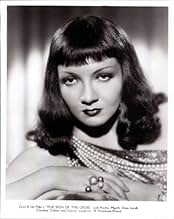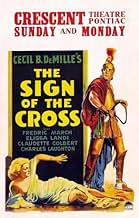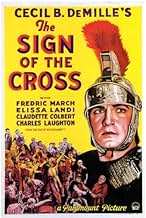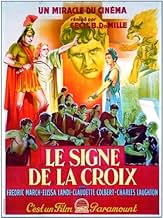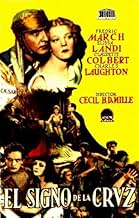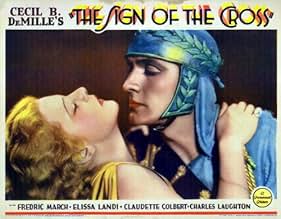VALUTAZIONE IMDb
6,8/10
2908
LA TUA VALUTAZIONE
Aggiungi una trama nella tua linguaA Roman soldier becomes torn between his love for a Christian woman and his loyalty to Emperor Nero.A Roman soldier becomes torn between his love for a Christian woman and his loyalty to Emperor Nero.A Roman soldier becomes torn between his love for a Christian woman and his loyalty to Emperor Nero.
- Regia
- Sceneggiatura
- Star
- Candidato a 1 Oscar
- 3 vittorie e 1 candidatura in totale
Joyzelle Joyner
- Ancaria
- (as Joyzelle)
Robert Seiter
- Philodemus
- (as Robert Manning)
Recensioni in evidenza
Hollywood legend has it that DeMille cast Claudette Colbert as Poppaea by asking her if she'd like to play the "wickedest woman in the world". Who could refuse an offer like that? There are already quite a few excellent (and fun) reviews in this column now, but in view of the DVD release I'd like to add a few things. This lavish picture shows DeMille at his best, worst, most decadent and most unusual. I first saw the expurgated World War II era re-release on TV ages ago, and wasn't much impressed. My father said they'd bowdlerized it a lot, so I was curious to see the 1932 original when it appeared on VHS a few years back. "Astound Me" Diaghilev once famously said to Cocteau; and astounded I was. I was expecting a lot more craziness, but I wasn't expecting to see elephants stepping on men's heads or naked women being eaten by crocodiles. Released in December 1932 it is marginally a pre-code movie, but surely only DeMille could have gotten away with it. This movie has nothing to do with Hollywood of the Thirties; this is Hollywood of the Twenties having one last outrageous fling, with all its sex, drugs, decadence, and all round insanity. The movie plays very much like a silent; perhaps it should have been a silent, thus sparing us its greatest defect, which is some of the worst dialog ever perpetrated. Fredric March as Marcus, the male lead, struggles manfully with awful lines throughout; but it is the visual aspect which dominates one's attention. Consider Colbert's legendary bath in a veritable swimming pool filled with milk (and she's really naked under all that milk). A friend, played by Vivian Tobin with kittenish glee, arrives; they exchange a few verbal barbs worthy of a pair of snarky teenagers, then Poppaea simply says "Take off your clothes. Get in here and tell me all about it." Anyone who thinks the naughty implications of this were inadvertent in innocent old 1932 hasn't spent much time in Hollywood Babylon, to say nothing of Hollywood Rome. Colbert is a delight throughout; her scenes with Fredric March play as high comedy. As he desperately tries to assert his nobility and self control, Colbert effortlessly demolishes his dignity with the perfect lazy grace of a leopardess. And let's not forget Charles Laughton, whose Nero is a masterpiece of omnisexual megalomania. Only Peter Ustinov in the 1951 "Quo Vadis" could better him.
This is on the surface a standard lions vs. Christians epic, but it ain't one to take your Sunday School class to. Under no circumstances should this be viewed by kids, even today. Much of the imagery is equivocal, to put it politely, especially during the big arena show that fills the last half hour. And then there's Marcus' big party, where Joyzelle Joyner performs a dance that is startlingly obscene for 1932.
All of this is ravishingly photographed by cameraman Karl Struss, one of the great artists of monochrome, who makes every shot a work of art. There is one scene in the house occupied by Mercia and her aged guardian, where the old man is seen in a hallway with a gate and small yard beyond; in the yard is an urn. The whole shot is lit by a single brilliant light blasting down on the urn, with bounce boards sending the light gently into the house. This violates all the rules of how to light a scene, but the effect is magical. A quick word should also be put in for Rudolph Kopp, who supplied the music (curiously uncredited); he actually has a go at recreating an authentic ancient Roman sound (no actual ancient Roman music survives).
But the core of the picture is the last part, the ultimate Roman circus. DeMille does something genuinely startling here. First he invites us, a little salaciously, to watch the spectacle, which begins with gladiatorial combat, but proceeds to darker and darker exhibits, many of which are genuinely disturbing (I wasn't kidding about the naked women and the crocodiles; wait until you see the Gaulish Amazon women vs. the Pygmies). As it gets more and more evil, we keep cutting to vivid closeups of the audience that we have been invited to join; some excited, some revolted, some merciless, some bored to distraction, some filled with pity, some sadistic, some almost drooling with voyeurism; they are us, and we are them. DeMille has had the effrontery to show us our own faces as we feast our eyes on all this exquisitely photographed mayhem. It's not easy to watch, and I know of nothing else quite like it prior to Stanley Kubrick.
This is on the surface a standard lions vs. Christians epic, but it ain't one to take your Sunday School class to. Under no circumstances should this be viewed by kids, even today. Much of the imagery is equivocal, to put it politely, especially during the big arena show that fills the last half hour. And then there's Marcus' big party, where Joyzelle Joyner performs a dance that is startlingly obscene for 1932.
All of this is ravishingly photographed by cameraman Karl Struss, one of the great artists of monochrome, who makes every shot a work of art. There is one scene in the house occupied by Mercia and her aged guardian, where the old man is seen in a hallway with a gate and small yard beyond; in the yard is an urn. The whole shot is lit by a single brilliant light blasting down on the urn, with bounce boards sending the light gently into the house. This violates all the rules of how to light a scene, but the effect is magical. A quick word should also be put in for Rudolph Kopp, who supplied the music (curiously uncredited); he actually has a go at recreating an authentic ancient Roman sound (no actual ancient Roman music survives).
But the core of the picture is the last part, the ultimate Roman circus. DeMille does something genuinely startling here. First he invites us, a little salaciously, to watch the spectacle, which begins with gladiatorial combat, but proceeds to darker and darker exhibits, many of which are genuinely disturbing (I wasn't kidding about the naked women and the crocodiles; wait until you see the Gaulish Amazon women vs. the Pygmies). As it gets more and more evil, we keep cutting to vivid closeups of the audience that we have been invited to join; some excited, some revolted, some merciless, some bored to distraction, some filled with pity, some sadistic, some almost drooling with voyeurism; they are us, and we are them. DeMille has had the effrontery to show us our own faces as we feast our eyes on all this exquisitely photographed mayhem. It's not easy to watch, and I know of nothing else quite like it prior to Stanley Kubrick.
Yikes! De Mille's erotic raunchy graphic and splendid SIGN OF THE CROSS made at Paramount in 1932, and his first talkie bible study is a movie you not forget. It is infamous and famous for many sights and other comments here will give you the reaction to the graphic cruelty of the truly shocking Arena/Gladiator scenes. The ridiculously entertaining asses milk bath with nipples ahoy and Claudette's milky breasts, the very funny dialog of daily life amid the splendor, the horror of the rape and torture of a teenage Christian boy, the eerie similarity to the 1932 German persecution of the European Jews, the depression era parable of the idle rich uncaring at the financial death of the 1930s masses, the dazzling costumes (no bras in Rome either), the claustrophobic street sets with rushing horses and fights in corners, all in all create an amazing action tableau like a pencil sketch bible book drawing brought to life. The film's art direction and set design and costumes are especially evocative of 'a silent epic with sound' and one easily can transfer the idea of seeing the 1925 BEN HUR with sound as SIGN OF THE CROSS favorably compares. The Arena montage scenes are really shocking. The Moon Dance is outrageous lesbian swankiness and gorgeous as all hell... well pagan hell as depicted by the morally austere Demille. Great moving wallpaper for your next party if played on a big TV and without sound with your CD collection going instead. If you agree that SIGN OF THE CROSS made in 1932 is really a 1920s silent film with dialog, have a look at FOLLOW THRU made two years earlier in 1929 and in color and as jazz modern today in it's creative style. CROSS plays like an ancient movie but FOLLOW THRU still plays new.
My favorite DeMille film. Charles Laughton and Claudette Colbert are delicious as the debauched emperor and empress of Rome. Prominent supporting players Arthur Hohl and Harry Beresford appeared in two horror classics (ISLAND OF LOST SOULS and DOCTOR X, respectively) the very same year. John Carradine can be seen as a condemned Christian on his way to the arena (you can also hear his voice as a spectator and as a gladiator). Very sharp viewers can also spot Dave O'Brien (a condemned Christian) and Kent Taylor (a disinterested spectator). Three famous scenes still impress today: Poppaea's milk bath; Ancaria's attempted lesbian seduction of Mercia; the outrageous arena sequence featuring beheadings, burnings, impalements, hungry crocodiles, untamed apes, bears, tigers and, of course, lions. Only C.B. could have gotten away with this in 1932! The closing cast list includes the characters Viturius, Servillius and Philodemus, but I'm not sure who they are. Viturius may have been Marcus' soldier-aide, although he doesn't look as burly as Richard Alexander. The other two must be Strabo's ugly, brutish companion and the old Christian man protective of the little orphan girl.
THE SIGN OF THE CROSS (Paramount, 1932), directed by Cecil B. DeMille, returns its director to the genre to what he's best known, the religious spectacle, his first since THE KING OF KINGS (Pathe, 1927) starring H.B. Warner as Jesus the Christ. While this title certainly indicates another retelling into the life of Christ, the script, taken from an old play by Wilson Barrett, focuses more on Christians following in the teachings of Jesus years after His crucifixion, only to face suffering and prosecution for their faith.
The setting is 64 A.D. where the Emperor Nero (Charles Laughton) is introduced playing his lyre while watching in laughter the flames raging through the city of Rome. Although responsible for starting the fire, Nero places the blame on the Christians, arranging for his guards to have them placed under arrest. His wife, Poppara (Claudette Colbert), is an adulteress whose only desire is the manly Marcus Superbus (Fredric March), a prefect of Rome, but cannot put her hold on him after learning from Dacia (Vivian Tobin) of his love for Mercia (Elissa Landi), a Christian girl. As much as Marcus believes "Christianity is stupid," he tries his best to persuade Mercia to renounce her faith and marry him. Tigellinus (Ian Keith), Marcus' rival, sees an opportunity in making trouble for them both.
With crime dramas, drawing room comedies and/or social related issues as common theme during the Depression era, THE SIGN OF THE CROSS was something out of the ordinary. In true DeMille fashion, THE SIGN OF THE CROSS is not only a 128 minute spectacle with a three minute intermission in the midway point, but a large-scale production with lavish sets and cast of thousands accurately costumed according to its time structure. Of the performers in this Biblical story, Elissa Landi, the central character, seems out of place with her 1932 head-dress while Claudette Colbert, in her first "bad girl" role, quite evident with her lipstick and pencil drawn eyelashes, has her cherished moment bathing in a pool of milk gulped along side by two kittens at a distance. Fredric March as the Roman soldier who rules with the cracking of his whip, physically makes a convincing Marcus, though some of his badly scripted dialog, along with others in the cast, may provoke laughter for any contemporary viewer. Charles Laughton's Nero is exceptional, right down to his curly hair with added putty in the middle of his nose adding sharpness to his cruel facial expression. Although his scenes are regrettably limited, Laughton simply stands out, especially as he watches in sleepy-eyed boredom the slaughter of victims at the arena as he sits back eating large portions of food. Other members in the large cast include Tommy Conlan as Stephanus, the teenage Christian boy; Nat Pendleton, Arthur Hohl, Charles Middleton; lions, tigers, crocodiles and elephants as uncredited extras.
As much as the plot was reworked into the MGM spectacle of QUO VADIS (1951) starring Robert Taylor as Marcus; with Deborah Kerr and Peter Ustinov giving a tour-da-force performance as Nero, nothing can compare with the intense arena sequence found in THE SIGN OF THE CROSS. Graphic, then and now, this sequence, along with "The Naked Moon" dance performed by the wicked Ancaria (Joyzelle Joyner), was all that was missing when THE SIGN OF THE CROSS was not only reissued to theaters in 1944, but when sold to commercial television around the 1960s. In its place was a ten minute prologue written by Dudley Nichols, set during World War II with the cast featuring Stanley Ridges (Chaplain Thomas Lloyd); Arthur Shields (Captain James Costello); James Millican (Captain Kevin Driscoll); William Forrest (Colonel Hugh Mason); Tom Tully (Hoboken); Oliver Thorndyke (Lieutenant Roger Hammond); and Joel Allen. The new opening revolves around bombardiers being assigned on a dangerous mission and heading out to their destination. As the airplane flies over the Colosseum, a discussion about to the prosecution of Christians under Nero's regime leads to a flashback and events that takes place.
It wasn't until March 14, 1993, when American Movie Classics cable channel presented the original uncut 1932 theatrical release of THE SIGN OF THE CROSS that was obtained from the DeMille estate, and played it as part of AMC's initial Film Preservation Society festival. Without these missing scenes, THE SIGN OF THE CROSS would have been hopelessly dull and talkie, such as the case with the 1944 reissue that had circulated for nearly half a century. In 1995, Universal Home Video distributed the now uncensored 1932 version to home video and then to DVD in 2006. After AMC ceased airing THE SIGN OF THE CROSS in 1999, Turner Classic Movies picked up its option by airing this DeMille epic where it played from occasionally from 2004 to 2007. Regardless of its flaws, THE SIGN OF THE CROSS is prime DeMille, best suited for viewing during the season of Lent or Good Friday. Hail Caesar!! (***1/2)
The setting is 64 A.D. where the Emperor Nero (Charles Laughton) is introduced playing his lyre while watching in laughter the flames raging through the city of Rome. Although responsible for starting the fire, Nero places the blame on the Christians, arranging for his guards to have them placed under arrest. His wife, Poppara (Claudette Colbert), is an adulteress whose only desire is the manly Marcus Superbus (Fredric March), a prefect of Rome, but cannot put her hold on him after learning from Dacia (Vivian Tobin) of his love for Mercia (Elissa Landi), a Christian girl. As much as Marcus believes "Christianity is stupid," he tries his best to persuade Mercia to renounce her faith and marry him. Tigellinus (Ian Keith), Marcus' rival, sees an opportunity in making trouble for them both.
With crime dramas, drawing room comedies and/or social related issues as common theme during the Depression era, THE SIGN OF THE CROSS was something out of the ordinary. In true DeMille fashion, THE SIGN OF THE CROSS is not only a 128 minute spectacle with a three minute intermission in the midway point, but a large-scale production with lavish sets and cast of thousands accurately costumed according to its time structure. Of the performers in this Biblical story, Elissa Landi, the central character, seems out of place with her 1932 head-dress while Claudette Colbert, in her first "bad girl" role, quite evident with her lipstick and pencil drawn eyelashes, has her cherished moment bathing in a pool of milk gulped along side by two kittens at a distance. Fredric March as the Roman soldier who rules with the cracking of his whip, physically makes a convincing Marcus, though some of his badly scripted dialog, along with others in the cast, may provoke laughter for any contemporary viewer. Charles Laughton's Nero is exceptional, right down to his curly hair with added putty in the middle of his nose adding sharpness to his cruel facial expression. Although his scenes are regrettably limited, Laughton simply stands out, especially as he watches in sleepy-eyed boredom the slaughter of victims at the arena as he sits back eating large portions of food. Other members in the large cast include Tommy Conlan as Stephanus, the teenage Christian boy; Nat Pendleton, Arthur Hohl, Charles Middleton; lions, tigers, crocodiles and elephants as uncredited extras.
As much as the plot was reworked into the MGM spectacle of QUO VADIS (1951) starring Robert Taylor as Marcus; with Deborah Kerr and Peter Ustinov giving a tour-da-force performance as Nero, nothing can compare with the intense arena sequence found in THE SIGN OF THE CROSS. Graphic, then and now, this sequence, along with "The Naked Moon" dance performed by the wicked Ancaria (Joyzelle Joyner), was all that was missing when THE SIGN OF THE CROSS was not only reissued to theaters in 1944, but when sold to commercial television around the 1960s. In its place was a ten minute prologue written by Dudley Nichols, set during World War II with the cast featuring Stanley Ridges (Chaplain Thomas Lloyd); Arthur Shields (Captain James Costello); James Millican (Captain Kevin Driscoll); William Forrest (Colonel Hugh Mason); Tom Tully (Hoboken); Oliver Thorndyke (Lieutenant Roger Hammond); and Joel Allen. The new opening revolves around bombardiers being assigned on a dangerous mission and heading out to their destination. As the airplane flies over the Colosseum, a discussion about to the prosecution of Christians under Nero's regime leads to a flashback and events that takes place.
It wasn't until March 14, 1993, when American Movie Classics cable channel presented the original uncut 1932 theatrical release of THE SIGN OF THE CROSS that was obtained from the DeMille estate, and played it as part of AMC's initial Film Preservation Society festival. Without these missing scenes, THE SIGN OF THE CROSS would have been hopelessly dull and talkie, such as the case with the 1944 reissue that had circulated for nearly half a century. In 1995, Universal Home Video distributed the now uncensored 1932 version to home video and then to DVD in 2006. After AMC ceased airing THE SIGN OF THE CROSS in 1999, Turner Classic Movies picked up its option by airing this DeMille epic where it played from occasionally from 2004 to 2007. Regardless of its flaws, THE SIGN OF THE CROSS is prime DeMille, best suited for viewing during the season of Lent or Good Friday. Hail Caesar!! (***1/2)
One of the very first and one of the very best Roman epics on screen filled with DeMille's splendor!
A comment on the original 1932 version.
Pagan Rome, the third night of the great fire. Emperor Nero (Charles Laughton) unjustly condemns Christians of burning the eternal city and sentences many of them to martyrdom. He does not realize that through this deed he unconsciously opens for them a wonderful glory in a better world. The struggle between the sign of the Roman eagle of decadent Nero's times and the sign of the cross begins, this is, symbolically, the endless struggle between those with "delicious debauchery" as the sole aim of life (the lifestyle Nero's times promoted) and those heading for everlasting virtues like love, piety, forgiveness, and purity of heart. Cecil B DeMille's THE SIGN OF THE CROSS, being the first sound biblical epic after his silent KING OF KINGS (1927) is, though more than 70 years old, a great spectacle, still one of the most entertaining Roman epics, except for QUO VADIS (1951), SPARTACUS (1960), and BEN HUR (1959).
GREAT CAST: The outstanding cast in the movie are its strongest point. Claudette Colbert's portrayal of wicked, lustful Poppaea is gorgeous. The same can be said about Charles Laughton who portrays Nero as a really decadent emperor, entirely flooded in debauchery and all sorts of sinful lusts. There have been more portrayals of this cruel pair (Poppeae and Nero), but theirs from DeMille's film is real feast for the soul. Therefore, they are even more memorable than Elissa Landi and Fredric March playing the main roles of Mercia and Marcus. Indeed, March as Marcus Superbus does a good job, especially in the way he shows a change of heart from a mocker to a believer. Elissa Landi presents Mercia's innocence and virtues memorably. But they are not that terrific as Colbert and Laughton. As far as performances are concerned, it is also important to mention Joyzelle as "the most wicked and talented woman in Rome", Ancaria. The scene of her seduction is truly well played. The dance of the Naked Moon that Ancaria seduces on Mercia is disturbed by Christians singing in a dungeon. MORAL MESSAGE: That scene clearly expresses the fact I have mentioned at the beginning: the universal struggle between two groups of people with two different aims in life. I think that DeMille also wanted to show this moral in another scene: the meeting of two old Christian men, Favius and Titus sent by Paul to Rome. One of them draws the sign of the cross on the ground, which is later trodden on by many people walking in the square.
SIMILARITY TO ANOTHER EPIC: A significant fact is that the content of the movie is strikingly similar to another Roman epic, made almost 20 years later, QUO VADIS (1951) by Mervyn LeRoy. While QUO VADIS is based on the novel by Henryk Sienkiewicz, this film is based on a play by an English playwright, Wilson Barrett. Both films, however, present the 1st century Rome, in particular, spreading Christianity in the cruel times of Nero; both films show the conversion of a Roman soldier Marcus who loves a Christian girl; both films remind us of the secret Christian meetings; both films focus on Poppaea being lustful for Marcus and demanding revenge on Christians because of jealousy (consider the moment Marcus Superbus comes to Nero to ask him to spare the life of Mercia. Nero says: If she would publicly renounce her faith... when Poppaea disturbs radically: "Not even then!") Moreover, both films show Poppaea's beautiful leopards. Finally, THE SIGN OF THE CROSS and QUO VADIS show the arena sequence, however DeMille presents much more of its gore than LeRoy in 1951.
ARENA: Alligators feeding with a young Christian woman, elephants treading on people's heads, a gorilla raping a girl tied to a wooden pillar, people crucified and burned, men fighting with bulls, bears, women fighting with dwarfs; yet lions and tigers eating Christians, and many other cruel games to the joy and lust of the viewers. Indeed, it is a film not to be watched by kids even at the beginning of the 21 century, but historically accurate and visually very well made.
ONE OF CINEMA'S MOST MEMORABLE MOMENTS: Except for the cruel arena sequence, which is still entertaining in some way, any viewer will be surprised at one scene: Poppaea's famous milk bath. That's a moment that everyone should consider while watching the film. Her sexual bath is one of the best made moments that cinema has ever seen. It is totally filled with desire and sexuality. And all thanks to the great performance by Ms Colbert. No surprise Cecil B DeMille cast her to play Cleopatra two years later, in 1934.
It's difficult to express all I feel about this movie in one review. I simply tried my best to encourage everyone to see this movie because it was an unforgettable experience for me, one of the very best Roman epics of all time. If you have already seen QUO VADIS, you will find this movie very similar but, indeed, more DeMillean. The end is very much influenced by the 1930s cinema but very touching and universally true - the absolute victory always comes in the Sign of the Cross... 9/10
Pagan Rome, the third night of the great fire. Emperor Nero (Charles Laughton) unjustly condemns Christians of burning the eternal city and sentences many of them to martyrdom. He does not realize that through this deed he unconsciously opens for them a wonderful glory in a better world. The struggle between the sign of the Roman eagle of decadent Nero's times and the sign of the cross begins, this is, symbolically, the endless struggle between those with "delicious debauchery" as the sole aim of life (the lifestyle Nero's times promoted) and those heading for everlasting virtues like love, piety, forgiveness, and purity of heart. Cecil B DeMille's THE SIGN OF THE CROSS, being the first sound biblical epic after his silent KING OF KINGS (1927) is, though more than 70 years old, a great spectacle, still one of the most entertaining Roman epics, except for QUO VADIS (1951), SPARTACUS (1960), and BEN HUR (1959).
GREAT CAST: The outstanding cast in the movie are its strongest point. Claudette Colbert's portrayal of wicked, lustful Poppaea is gorgeous. The same can be said about Charles Laughton who portrays Nero as a really decadent emperor, entirely flooded in debauchery and all sorts of sinful lusts. There have been more portrayals of this cruel pair (Poppeae and Nero), but theirs from DeMille's film is real feast for the soul. Therefore, they are even more memorable than Elissa Landi and Fredric March playing the main roles of Mercia and Marcus. Indeed, March as Marcus Superbus does a good job, especially in the way he shows a change of heart from a mocker to a believer. Elissa Landi presents Mercia's innocence and virtues memorably. But they are not that terrific as Colbert and Laughton. As far as performances are concerned, it is also important to mention Joyzelle as "the most wicked and talented woman in Rome", Ancaria. The scene of her seduction is truly well played. The dance of the Naked Moon that Ancaria seduces on Mercia is disturbed by Christians singing in a dungeon. MORAL MESSAGE: That scene clearly expresses the fact I have mentioned at the beginning: the universal struggle between two groups of people with two different aims in life. I think that DeMille also wanted to show this moral in another scene: the meeting of two old Christian men, Favius and Titus sent by Paul to Rome. One of them draws the sign of the cross on the ground, which is later trodden on by many people walking in the square.
SIMILARITY TO ANOTHER EPIC: A significant fact is that the content of the movie is strikingly similar to another Roman epic, made almost 20 years later, QUO VADIS (1951) by Mervyn LeRoy. While QUO VADIS is based on the novel by Henryk Sienkiewicz, this film is based on a play by an English playwright, Wilson Barrett. Both films, however, present the 1st century Rome, in particular, spreading Christianity in the cruel times of Nero; both films show the conversion of a Roman soldier Marcus who loves a Christian girl; both films remind us of the secret Christian meetings; both films focus on Poppaea being lustful for Marcus and demanding revenge on Christians because of jealousy (consider the moment Marcus Superbus comes to Nero to ask him to spare the life of Mercia. Nero says: If she would publicly renounce her faith... when Poppaea disturbs radically: "Not even then!") Moreover, both films show Poppaea's beautiful leopards. Finally, THE SIGN OF THE CROSS and QUO VADIS show the arena sequence, however DeMille presents much more of its gore than LeRoy in 1951.
ARENA: Alligators feeding with a young Christian woman, elephants treading on people's heads, a gorilla raping a girl tied to a wooden pillar, people crucified and burned, men fighting with bulls, bears, women fighting with dwarfs; yet lions and tigers eating Christians, and many other cruel games to the joy and lust of the viewers. Indeed, it is a film not to be watched by kids even at the beginning of the 21 century, but historically accurate and visually very well made.
ONE OF CINEMA'S MOST MEMORABLE MOMENTS: Except for the cruel arena sequence, which is still entertaining in some way, any viewer will be surprised at one scene: Poppaea's famous milk bath. That's a moment that everyone should consider while watching the film. Her sexual bath is one of the best made moments that cinema has ever seen. It is totally filled with desire and sexuality. And all thanks to the great performance by Ms Colbert. No surprise Cecil B DeMille cast her to play Cleopatra two years later, in 1934.
It's difficult to express all I feel about this movie in one review. I simply tried my best to encourage everyone to see this movie because it was an unforgettable experience for me, one of the very best Roman epics of all time. If you have already seen QUO VADIS, you will find this movie very similar but, indeed, more DeMillean. The end is very much influenced by the 1930s cinema but very touching and universally true - the absolute victory always comes in the Sign of the Cross... 9/10
Lo sapevi?
- QuizCecil B. DeMille was pressured to drop Ancaria's seductive dance in the orgy scene by Will H. Hays of the Hays Office, but DeMille adamantly refused. Still, censors often cut out gruesome parts of the film, particularly, the cart carrying dead bodies out of the arena, a gorilla dancing around a semi-nude girl, elephants stomping Christians and picking them up with their tusks, crocodiles about to eat a bound girl, etc. These scenes are all in the restored version.
- BlooperWe see a woman tied up in the Coliseum as crocodiles are set loose on her. They are clearly alligators (broad snout), which were unknown to Europeans until Columbus's time, 15 centuries later. Only two countries have alligators: The United States and China.The Romans never went to either place.
- Versioni alternativeRe-released in 1944, with some cuts (sex and sadism scenes) and preceded by a nine minute prologue, set in present time with a WWII theme. This re-release version runs 118 minutes.
- ConnessioniEdited into Through the Centuries (1933)
- Colonne sonoreChristian Hymn No.1
(1932) (uncredited)
Music and Lyrics by Rudolph G. Kopp
Sung a cappella by Christians at the meeting
Reprised by them after their capture and at the arena
Sung a cappella by Elissa Landi and Tommy Conlon
Played and sung offscreen at the end
I più visti
Accedi per valutare e creare un elenco di titoli salvati per ottenere consigli personalizzati
- How long is The Sign of the Cross?Powered by Alexa
Dettagli
Botteghino
- Lordo Stati Uniti e Canada
- 5.971.004 USD
- Tempo di esecuzione
- 2h 5min(125 min)
- Colore
- Proporzioni
- 1.37 : 1
Contribuisci a questa pagina
Suggerisci una modifica o aggiungi i contenuti mancanti


